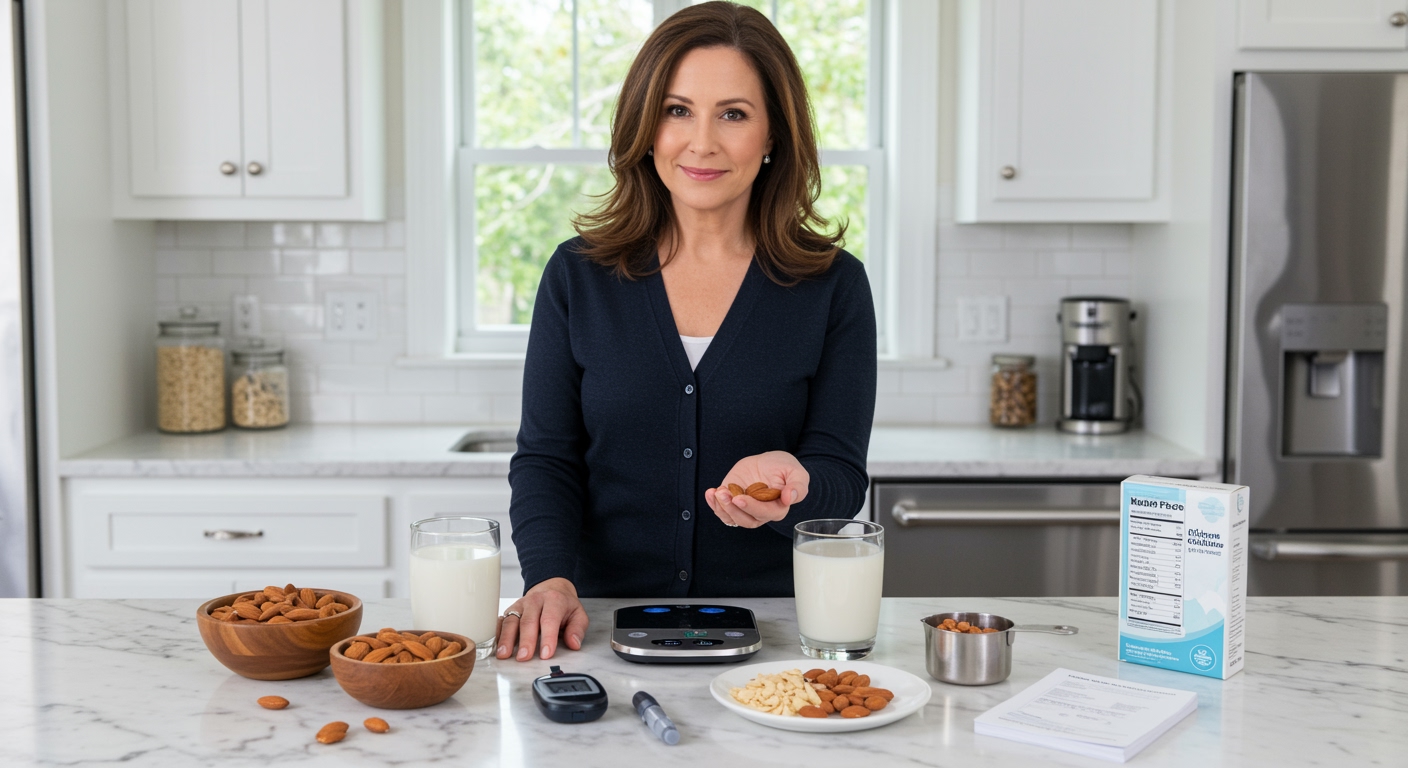✪ Key Takeaway: Almonds are excellent for diabetes because they have a low glycemic index and help stabilize blood sugar levels.
Introduction
You reach for that bag of almonds and wonder if you are making the right choice for your blood sugar.
Many people with diabetes feel confused about which snacks are truly safe because conflicting information floods the internet every day.
Hi, I am Abdur, your nutrition coach and today I am going to explain exactly how almonds affect your blood sugar and why they might be one of the best snacks for diabetes management.
What Makes Almonds Different From Other Snacks?
Almonds have a glycemic index of just 0 to 10, which means they barely raise your blood sugar at all.
This incredibly low number happens because almonds contain almost no digestible carbohydrates that your body can quickly convert to glucose.
Instead, almonds pack healthy fats, protein, and fiber that work together to slow down digestion and prevent blood sugar spikes.
The monounsaturated fats in almonds actually help your cells respond better to insulin, which is crucial for people managing diabetes.
Research shows that eating almonds before a meal can reduce the glycemic response of the entire meal by up to 30 percent.
This happens because the fat and protein in almonds slow down the emptying of your stomach, giving your body more time to process glucose gradually.
✪ Pro Tip: Eat 10-15 almonds about 30 minutes before your main meal to help control post-meal blood sugar spikes.
How Do Almonds Actually Help Control Blood Sugar?
The magic happens in your digestive system when almonds interact with other foods you eat.
Almonds contain alpha-glucosidase inhibitors, natural compounds that slow down the enzymes responsible for breaking down carbohydrates into sugar.
This means when you eat almonds with carbohydrate-rich foods, your body absorbs glucose more slowly and steadily.
The magnesium in almonds plays a crucial role in glucose metabolism by helping your cells use insulin more effectively.
Studies show that people with diabetes often have lower magnesium levels, and increasing magnesium intake through foods like almonds can improve insulin sensitivity.
The fiber in almonds also feeds beneficial gut bacteria that produce short-chain fatty acids, which help regulate blood sugar levels throughout the day.
✪ Fact: One ounce of almonds provides about 20% of your daily magnesium needs, supporting better glucose control.
What Does The Research Say About Almonds And Diabetes?
Multiple clinical studies have proven that almonds provide significant benefits for people with diabetes and prediabetes.
A 2021 study published in the journal Nutrients found that eating 43 grams of almonds daily for 12 weeks improved HbA1c levels in people with type 2 diabetes.
Another research study showed that people who ate almonds as a snack had better postprandial glucose responses compared to those who ate crackers or other processed snacks.
The PREDIMED study, one of the largest nutrition studies ever conducted, found that people who ate nuts regularly had a 52% lower risk of developing type 2 diabetes.
Researchers at Oregon State University discovered that daily almond consumption improved insulin sensitivity and reduced inflammation markers in people with metabolic syndrome.
These studies consistently show that almonds not only help manage existing diabetes but may also help prevent the condition from developing in the first place.
✪ Note: Most studies used about 1-1.5 ounces of almonds daily, which equals roughly 23-35 individual almonds.
How Many Almonds Should You Eat With Diabetes?
The optimal amount of almonds for diabetes management is one ounce per day, which equals about 23 whole almonds.
This portion provides approximately 160 calories, 6 grams of protein, 3.5 grams of fiber, and 14 grams of healthy fats.
You can divide this amount throughout the day, eating 7-8 almonds as a mid-morning snack and another 15 almonds in the afternoon.
Timing matters because eating almonds before meals provides the greatest benefit for blood sugar control.
Avoid eating more than 2 ounces of almonds daily because the high calorie content can lead to weight gain, which negatively affects diabetes management.
Choose raw or dry-roasted almonds without added salt, sugar, or oils to maximize the health benefits and avoid unnecessary additives that might affect your blood sugar.
✪ Pro Tip: Keep pre-portioned bags of 23 almonds ready so you never accidentally overeat this healthy snack.
Are There Any Risks Of Eating Almonds With Diabetes?
Almonds are generally safe for people with diabetes, but a few considerations can help you avoid potential problems.
The biggest risk comes from portion control because almonds are calorie-dense and easy to overeat when you are not paying attention.
Some people experience digestive discomfort when they suddenly increase their fiber intake through almonds, so start with smaller portions and gradually increase.
Flavored almonds often contain added sugars, honey, or artificial sweeteners that can affect your blood glucose levels unpredictably.
If you take blood-thinning medications, talk to your doctor before eating large amounts of almonds because they contain vitamin E, which can enhance the effects of these medications.
People with tree nut allergies obviously cannot eat almonds, but this is rare and usually diagnosed early in life.
✪ Note: Always read ingredient labels on flavored almonds because manufacturers often add hidden sugars and unhealthy oils.
The Bottom Line
Almonds are one of the best snack choices for people with diabetes because they help stabilize blood sugar, improve insulin sensitivity, and provide essential nutrients without causing glucose spikes.
The key to diabetes management is not avoiding all foods, but choosing the right foods in the right amounts at the right times.
I would love to hear about your experience with almonds and blood sugar management, so please share your questions or feedback in the comments section below.
References
At NutritionCrown, we use quality and credible sources to ensure our content is accurate and trustworthy. Below are the sources referenced in creating this article:





